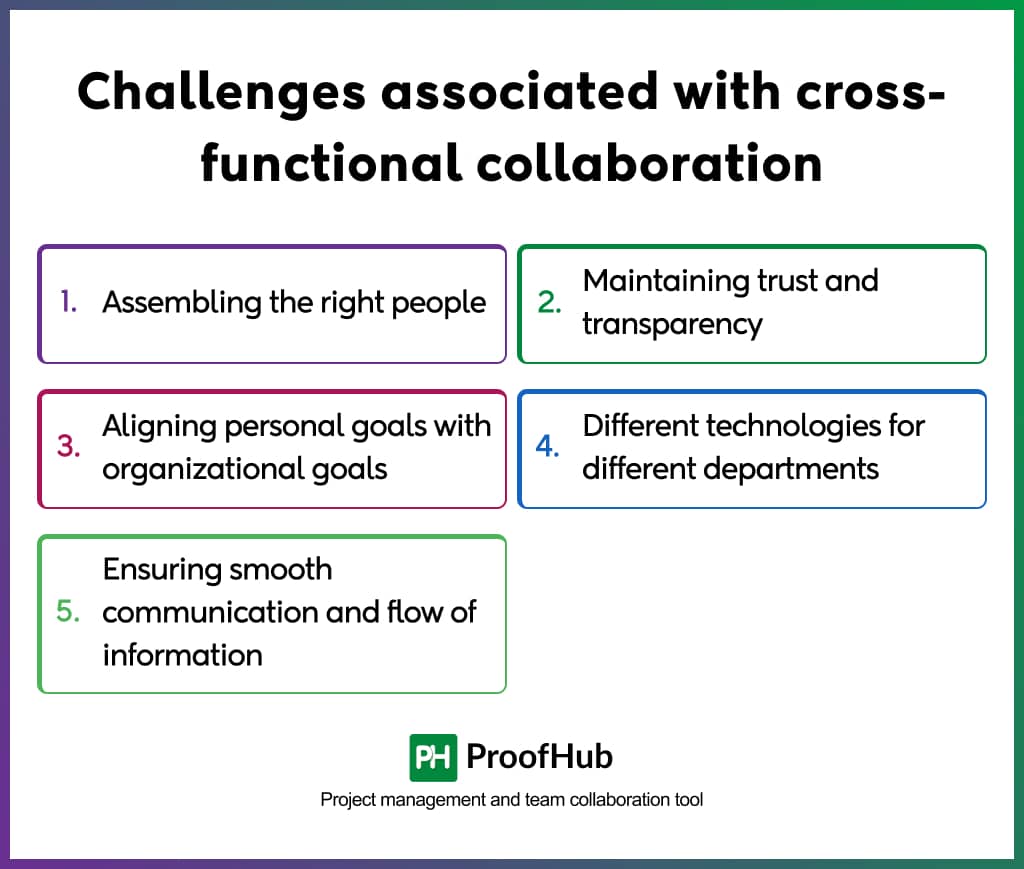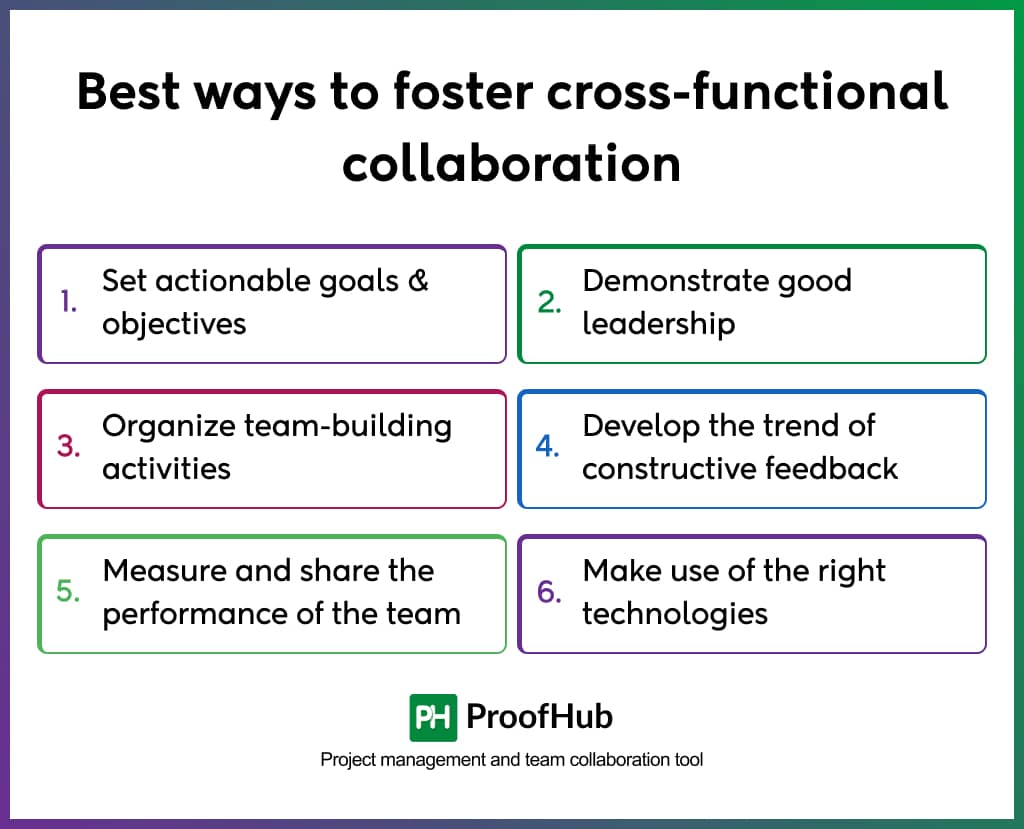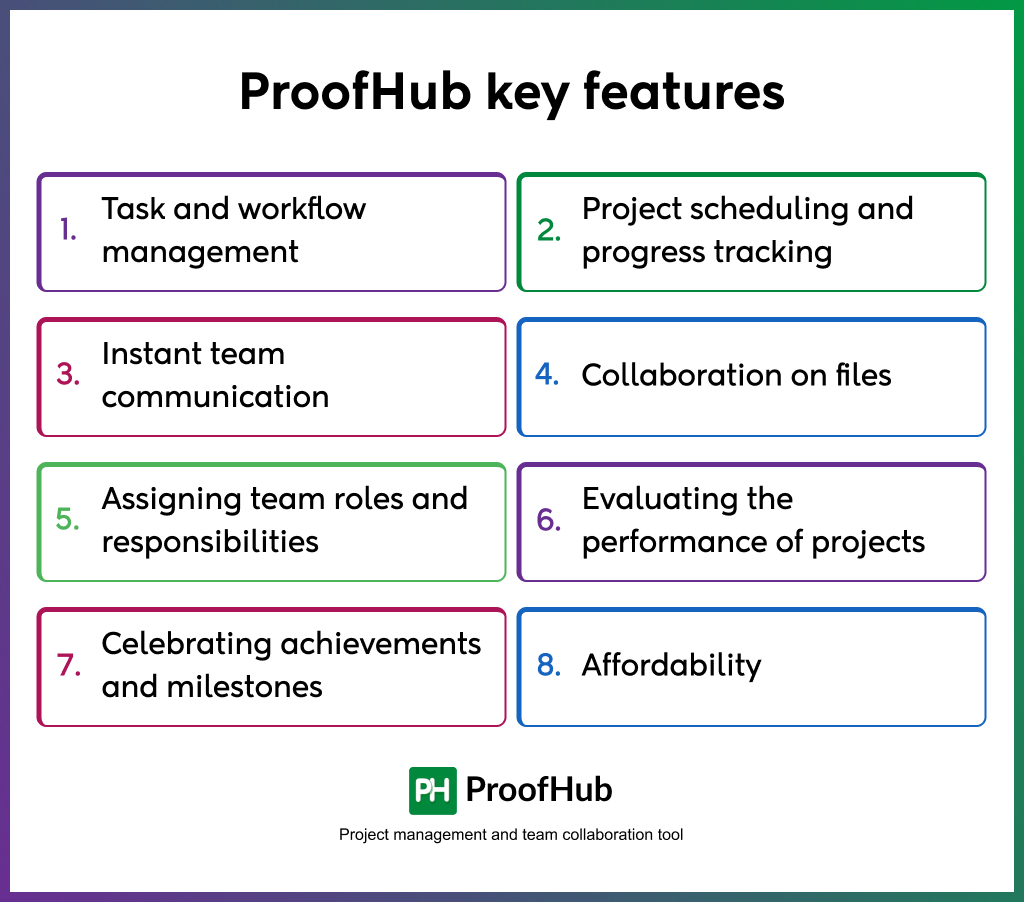Introduction
In today’s fast-paced and dynamic business environment, organizations are increasingly relying on cross-functional collaboration to tackle complex projects and drive innovation.
This article will explore the concept of cross-functional collaboration, its key benefits, and the challenges that may arise while implementing it. We will also discuss effective strategies to foster cross-functional teamwork.
What is Cross-functional collaboration?
Cross-functional collaboration is the approach by which individuals with various backgrounds in the workplace or functional areas collaborate as a team to complete shared tasks or projects. Generally, organizations select individuals from different departments and assemble them to leverage their wide range of skills for executing complex projects faster.
Cross-functional collaboration holds special importance for any organization. Such collaboration allows you to establish high-performance teams that can deliver quality products and services.
Cross-functional team collaboration makes the business’s processes more efficient, ensuring better customer service, and boosting the overall profitability of the organization.
What are the key benefits of cross-functional collaboration?
No doubt, making cross-functional team collaboration prosper in your organization is a tough row to hoe. However, once you become successful in doing so, you are going to enjoy the amazing benefits that it brings, you will know all your efforts are completely worth it. Here are some of the benefits of cross-functional team collaboration.

1. Knowledge sharing and learning
Any organization would love to enhance the skill sets of their employees so that both the quality and quantity of their work become better. The cross-functional team collaboration makes it possible for your employees to learn and develop new skills from their fellow teammates.
When people having expertise in different fields collaborate, they share their knowledge, which ultimately creates an environment of continuous learning. This is also one of the key reasons for cross-functional teams to be able to confront difficult situations gracefully.
2. Diverse skill set
Uniting experts from different disciplines allows your organization to tap into their skills and come up with innovative ideas and solutions. Additionally, the brainstorming sessions within a team that has expertise in a wide range of subjects are highly effective. Moreover, the focus of team members is to think out of the box and try to see things from a new and unique perspective.
By leveraging the diverse range of skills and expertise of professionals, your organization can use a fresh approach to the way projects are developed. Moreover, there will be little to no hesitation in working on projects that are unique and demand innovation.
3. Teamwork culture
When people work in a group to accomplish a common set of goals, coordination and teamwork become important factors for achieving success. Similarly, when it comes to a cross-functional team, the unity and togetherness among the team members decide the existence of the group.
The collaboration of people from different teams sets an example for all other employees in your organization and allows them to understand the power of team spirit. As a result, your employees will value team collaboration and a work culture will be developed that is inspired by teamwork and synergy.
4. Enhanced communication
Smooth and effective communication of ideas is another important factor that supports cross-functional collaboration across teams. Employees working together in a cross-functional team take their communication skills to whole new levels. Interacting with people having different personalities and backgrounds makes it possible to become a good communicator.
As communication among employees acts as the cornerstone of team collaboration, you will see that employees understand each other better, and there will be fewer conflicts and a consistent flow of information.
5. Faster project delivery
This is probably the most valuable benefit from an organization’s point of view. It is also one of the major reasons that inspire organizations to employ cross-functional teams. These teams are capable of streamlining projects and completing tasks at a faster pace compared to regular times.
Additionally, there’s no need to collaborate with other departments as your cross-functional team will already have the best people from all the departments within your organization.
The ability to track and solve issues at almost any phase of the project without the need for any external help makes cross-functional teams self-sufficient.
In all, the individuals working in these teams know how to make the best use of the skills and experiences available at their disposal to develop and deliver projects on time.
6. Better management & leadership
Managing a cross-functional team is daunting as you are responsible for driving a team that is composed of highly skilled individuals having different personalities and work styles. Both your managerial and leadership skills become better when you manage a team having significant diversity.
It’s completely up to you if you want to only manage or lead the team as well. The leader of a cross-functional team should have a good amount of knowledge of every field that the team members belong to.
As a leader in cross-functional team leadership, you must be able to understand the issues that your team faces and make decisions to overcome them.
What are the challenges associated with cross-functional collaboration?
As I have said earlier, incorporating cross-functional team collaboration in your organization is easier said than done. Here are some challenges that you will come across while setting up a cross-functional team:

1. Assembling the right people
It’s not just that you randomly pick some of the best-performing individuals from different departments and direct them to work on common objectives. You need to carefully select people who have the desired set of skills and experience to work on the projects intended for them.
Also, working in a dynamic environment with people from different professional backgrounds is not everyone’s cup of tea. So, you need to make sure that they are ready to work under different conditions.
2. Maintaining trust and transparency among the team members
When people from different departments come together, they find it difficult to trust each other. Team members who don’t trust each other cannot work together productively.
Moreover, they will not be able to coordinate and will feel disinterested in their responsibilities. Building trust in a cross-functional team requires you to create strategies that help team members form professional relationships with each other.
3. Aligning personal goals with organizational goals
The professional goals of individuals are highly field-specific. It means that their goals are oriented towards the field that they are working in such as marketing, software development, customer service & support, etc.
When you bring people together from different departments, they start to feel that they are working in an environment that may not help them achieve their goals.
It is your responsibility to make the employees aware of the benefits and growth opportunities that cross-functional collaboration has to offer. You also need to make sure that they align their personal goals with the organization’s goals, which is important for them to deliver exceptional performance at work.
4. Different technologies for different departments
Another big challenge that comes with cross-functional team collaboration is to deal with different technologies. Almost every department uses a different set of tools and technologies to streamline their work.
When some individuals from those departments come together to work in a cross-functional team, they need their respective tools to work efficiently.
But how come a team will be able to coalesce when its members are using different tools for work?
For you, the challenge is to choose the right set of tools that make it possible for the cross-functional team to centralize their work. It’s imperative to ensure that the number of tools used by your team is as less as possible and the team members are ready to learn and adopt new tools and technologies.
5. Ensuring smooth communication and flow of information
Communication gaps hinder the effectiveness of cross-functional collaboration to a large extent. As different departments operate in isolation from others, they use their combination of strategies and methods for internal communication.
However, when people from these departments come together to operate as a single unit, they find it hard to communicate effectively. Devising new communication strategies and standardizing team communication tools become a new challenge.
For cross-functional collaboration to yield good results, you need to make sure that employees and team members can communicate with each other instantaneously and effectively. Developing strong cross-functional collaboration skills is essential to overcoming these communication barriers and ensuring successful teamwork.
Best ways to foster cross-functional collaboration in your organization
Exercising cross-functional team collaboration in the workplace is difficult and demands a significant amount of effort from your side, but it surely is achievable.
Here are some established ways that will make it easier for you to make cross-functional team collaboration work for your organization:

1. Set actionable goals & objectives
The foremost thing that you need to do while assembling a cross-functional team is to set goals that give a common direction to the efforts of team members. You need to understand that the perspectives and inspirations of each individual are different. If each member keeps their personal goals as the top priority, there will be conflicts and teams will stray.
To avoid this from happening and make the best out of the interdepartmental collaboration, you need to set up a middle-ground for every team member to coordinate and put efforts into achieving a shared set of goals.
2. Demonstrate good leadership
Leadership is one of the major factors that decide the success of your cross-functional collaboration. Furthermore, a good leader follows a proactive approach to tackle challenges and devises plans for everything to happen systematically.
As a leader, you need to make sure that your cross-functional teams take responsibility for their actions. Moreover, to inspire your team to give their best in accomplishing any task or project, you need to lead them by example. Additionally, you must guide your team and provide them with the assistance they need at different times.
3. Organize team-building activities
While the people in different teams are likely to have developed cordial relationships with one another. However, when cross-functional collaboration happens, they have to work in collaboration with new people.
Organizing team-building activities is the key to helping individuals from different backgrounds to come together and work as a single unit. Team building activities allow team members to know and naturally connect.
4. Develop the trend of constructive feedback
Feedback is of great value when people are working in a group. However, when it comes to a cross-functional team, sharing feedback can be a little challenging for you as well as the team members because of the diversity.
If you are the one leading the team, you need to have a good knowledge and understanding of different subjects to be able to give feedback effectively. Furthermore, constructive feedback allows team members to identify areas of improvement and enhance their performance accordingly.
Moreover, when individuals feel that they are learning new things and developing themselves as a part of a cross-functional team, they feel more connected and stay motivated.
5. Measure and share the performance of the team
The purpose of cross-functional team collaboration is to develop high-performance teams that can deliver exceptional results. Consequently, for the members of such a team, it’s important that they are aware of their performance and whether they are meeting the expectations of their organization.
You need to measure the performance of your team against KPIs (Key Performance Indicators) and share the results with the team members. Additionally, you must celebrate and recognize the achievements of your team.
6. Make use of the right technologies
To unlock the full potential of cross-functional collaboration, making the use of the right technologies is a must.
As cross-functional teams do not take any external help to complete their work, they should be equipped with tools & technologies that can make them more productive.
For instance, project management software will give your team a fair advantage in managing all the projects, tasks, and clients from one single space. Similarly, a team communication tool would be great for your cross-functional team to initiate conversations and stay connected.
Why ProofHub is a great tool for cross-team collaboration?
ProofHub is an all-in-one project management and team collaboration software that teams can use to stay intact and deliver better quality work. It has been designed meticulously to help you and your team gain full control over projects while paving the way for effective team communication.
The software comes integrated with all the essential tools that your team needs to plan, collaborate, organize, and deliver projects.
Moreover, ProofHub allows you to manage all your teams operating under different departments and also facilitates cross-team collaboration. It is among the most popular tools that business owners and managers trust to incorporate cross-functional collaboration in their organizations.
While ProofHub has a vast range of features, we will only introduce some of its most celebrated features:
ProofHub key features

1. Task and workflow management
With Kanban boards, you can streamline the workflow of your projects and manage tasks in a well-organized manner. Every project has its own dedicated Kanban board. You can define the stages of the projects and see tasks moving through those stages during the project development.
Moreover, the Kanban board also lets you add new tasks within a project, select assignees for each task, and monitor task progress. Above that, you can simply open a task card to get all the details about the task, attach files, add comments, and create subtasks.
2. Project scheduling and progress tracking
Defining task schedules, setting task dependencies, prioritizing tasks, visualizing tasks in a timeline view, etc. are what you can do with ProofHub’s Gantt charts.
Also, you can identify the critical path of a project and identify tasks that affect the overall project timeline. It’s also easy to modify task schedules by simply dragging and dropping tasks on the Gantt chart.
3. Instant team communication
The in-built chat tool allows you and your team to have a quick conversation over text messages. Start a one-on-one conversation or create a group to chat with multiple team members simultaneously. Apart from the text, you can also share documents, images, videos, and other types of files using the chat interface in ProofHub.
4. Collaboration on files
The online proofing feature makes it possible to speed up the file review and approval process for your team. You can share designs & documents with your team, provide your feedback as comments, and make approvals with a single click.
Moreover, ProofHub also supports file versioning, which means that you can upload and share multiple versions of the same file. This makes it possible to compare the new version of a file with its older versions and review the changes easily.
5. Assigning team roles and responsibilities
With ProofHub, you can have ultimate control over your team and you can decide who gets to access what within a project. The custom roles in ProofHub let you create and assign different roles to the people in your cross-functional team. You also get the privilege to decide the access level for each role.
Furthermore, to make sure that the confidential information of a project is not accessible to everyone on the team, then you can revoke access to certain sections.
6. Evaluating the performance of projects and resources
Monitoring the performance of projects and the people on your team becomes quite easy with ProofHub’s advanced reporting capabilities. You can even create custom project reports and select parameters of your choice to highlight specific data.
Furthermore, the resource reports are also customizable and come in handy for assessing the performance of individual team members.
7. Celebrating achievements and milestones
ProofHub has a dedicated announcement section, where you can recognize the achievements of your team, give birthday greetings, or even make formal announcements. Also, you can select people who can see an announcement and set the duration for which it will remain visible.
8. Affordability (Pricing)
ProofHub’s affordable plans make it the best tool for cross-functional collaboration. For information on our pricing plans, kindly visit our pricing page.
To sum it up
You can easily enrich the performance of your team with cross-functional collaboration. Additionally, it allows you to create specialized teams by selecting people from different professional backgrounds or departments.
Remember, cross-functional teams are capable of executing complex projects while keeping innovation and efficiency as their top priorities. Effective cross-functional communication is key to ensuring that these teams work together seamlessly and achieve their goals.
However, to make cross-functional team collaboration successful for your organization, you need to be aware of its challenges so that you can prepare for them beforehand. The ways that I’ve mentioned in this article can help you establish cross-functional collaboration effectively.
Implement them, and let them transform your workplace into a happy, productive, and innovative one!
Related articles
- Steps to improve project collaboration for maximized efficiency
- Cross-functional teams: The future of corporate teamwork
- 52 Best online collaboration tools for 2025
- Why is real-time collaboration necessary & how can you achieve It?
- Experts share thoughts: A team collaboration strategy that helped them save projects from failing

